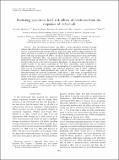Files in this item
Predicting population-level risk effects of predation from the responses of individuals
Item metadata
| dc.contributor.author | Macleod, Colin D. | |
| dc.contributor.author | Macleod, Ross | |
| dc.contributor.author | Learmonth, Jennifer A. | |
| dc.contributor.author | Cresswell, Will | |
| dc.contributor.author | Pierce, G.J. | |
| dc.date.accessioned | 2015-06-02T09:40:03Z | |
| dc.date.available | 2015-06-02T09:40:03Z | |
| dc.date.issued | 2014-07-01 | |
| dc.identifier | 118991883 | |
| dc.identifier | 6ffa1f7a-7bf7-478b-91f5-8283fad5c244 | |
| dc.identifier | 84904334650 | |
| dc.identifier | 000339470500027 | |
| dc.identifier.citation | Macleod , C D , Macleod , R , Learmonth , J A , Cresswell , W & Pierce , G J 2014 , ' Predicting population-level risk effects of predation from the responses of individuals ' , Ecology , vol. 95 , no. 7 , pp. 2006-2015 . https://doi.org/10.1890/13-1795.1 | en |
| dc.identifier.issn | 0012-9658 | |
| dc.identifier.other | ORCID: /0000-0002-4684-7624/work/60426963 | |
| dc.identifier.uri | https://hdl.handle.net/10023/6725 | |
| dc.description | This work formed part of the EU‐funded BIOCET project (Bioaccumulation of persistent organic pollutants in small cetaceans in European waters: transport pathways and impact on reproduction, EVK3‐2000‐00027). The UK marine mammal strandings program, funded by DEFRA as part of its commitment to the Agreement on the Conservation of Small Cetaceans of the Baltic and North Seas, supported attendance at strandings and necropsies. R. MacLeod is supported by a Royal Society of Edinburgh Scottish Government Research Fellowship. | en |
| dc.description.abstract | Fear of predation produces large effects on prey population dynamics through indirect risk effects that can cause even greater impacts than direct predation mortality. As yet, there is no general theoretical framework for predicting when and how these population risk effects will arise in specific prey populations, meaning there is often little consideration given to the key role predator risk effects can play in understanding conservation and wildlife management challenges. Here, we propose population predator risk effects can be predicted through an extension of individual risk trade-off theory and show for the first time that this is the case in a wild vertebrate system. Specifically, we demonstrate that the timing (in specific months of the year), occurrence (at low food availability), cause (reduction in individual energy reserves) and type (starvation mortality) of a population level predator risk effect can be successfully predicted from individual responses using a widely applicable theoretical framework (individual based risk trade-off theory). Our results suggest individually-based risk-trade-off frameworks could allow a wide range of population level predator risk effects to be predicted from existing ecological theory, which would enable risk effects to be more routinely integrated into consideration of population processes and in applied situations such as conservation. | |
| dc.format.extent | 10 | |
| dc.format.extent | 440564 | |
| dc.language.iso | eng | |
| dc.relation.ispartof | Ecology | en |
| dc.subject | Bottlenose dolphin; Tursiops truncates | en |
| dc.subject | Harbor porpoise; Phocoena phocoena | en |
| dc.subject | Indirect effects | en |
| dc.subject | Individual-based theory | en |
| dc.subject | Lethal porpoise-dolphin interactons | en |
| dc.subject | Mass-dependent predation risk | en |
| dc.subject | Nonconsumptive effects | en |
| dc.subject | Nonlethal predator effects | en |
| dc.subject | Sandeel; Ammodytes marinus | en |
| dc.subject | Scotland | en |
| dc.subject | Starvation-predation risk trade-off | en |
| dc.subject | QH301 Biology | en |
| dc.subject | BDC | en |
| dc.subject.lcc | QH301 | en |
| dc.title | Predicting population-level risk effects of predation from the responses of individuals | en |
| dc.type | Journal article | en |
| dc.contributor.institution | University of St Andrews. School of Biology | en |
| dc.contributor.institution | University of St Andrews. Scottish Oceans Institute | en |
| dc.contributor.institution | University of St Andrews. Institute of Behavioural and Neural Sciences | en |
| dc.contributor.institution | University of St Andrews. St Andrews Sustainability Institute | en |
| dc.contributor.institution | University of St Andrews. Centre for Biological Diversity | en |
| dc.identifier.doi | https://doi.org/10.1890/13-1795.1 | |
| dc.description.status | Peer reviewed | en |
This item appears in the following Collection(s)
Items in the St Andrews Research Repository are protected by copyright, with all rights reserved, unless otherwise indicated.

